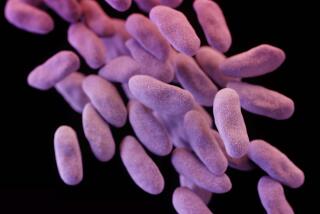“Super Bugs” Have Invaded Our Meat
BOSTON — As each day brings more news of anthrax contamination, health officials have sought to reassure an anxious public by emphasizing that antibiotics such as Cipro have proved effective against this infection. It’s not surprising, given the fear level, that many Americans are stockpiling antibiotics. But while antibiotics may indeed seem like our saviors in the shadow of anthrax, widespread usage itself carries dangers that extend far beyond the current crisis.
It’s an inescapable law of nature that the use of antibiotics leads to the development of “super bugs”--resistant germs that are not just hardier but also more dangerous than their ancestors. The notion that bacteria can become resistant to antibiotics is no longer just an interesting research question: It has become a concrete and urgent fear as we contemplate what would happen in the event of an all-out biological assault. We cannot afford to squander the effectiveness of antibiotics by misuse.
The heavy traffic in Cipro in the anthrax era has spotlighted the problem of antibiotic-resistant germs. But while we focus on the looming consequences of abusing Cipro and the excessive prescription of antibiotics in general, the agriculture industry has already created its own “super bugs” through routine use of low-dose antibiotics in livestock feed. This practice is more insidious because most consumers are unaware of its already serious consequences.
For nearly half a century, low doses of antibiotics have been routinely given to healthy farm animals and poultry to hasten their growth and thereby increase profits. We know this practice is ubiquitous, but there is much we don’t know. Manufacturers of livestock antibiotics are not required to release production figures, so we have no accurate means of gauging the amount of antibiotics consumed each year by the nation’s farm animals.
One conservative estimate is that half of the total antibiotics produced in the U.S. are administered to animals, mostly for growth promotion. Other estimates are much higher. The Union of Concerned Scientists recently calculated that 24.6 million pounds of antibiotics are given annually to pigs, chickens and cows to promote their growth and another 2 million pounds for treating their diseases: By comparison, 3 million pounds are given to humans. Whichever figures are accepted, it is fair to state that substantial amounts of antibiotics are administered to food animals for growth promotion, not for their intended purpose, to treat infectious diseases.
The impact of such widespread antibiotic use in agriculture has been of concern to scientists for some years. But it’s only recently that we’ve had proof that the antibiotics are affecting bacteria in potentially devastating ways. Scientists from the Centers for Disease Control and Prevention reported last month in the New England Journal of Medicine that one in five ground-meat and poultry packages they examined was contaminated by salmonella, one of the leading causes of food poisoning. Even more alarming: Some 84% of these germs were resistant to at least one antibiotic, and most were resistance to several.
Other studies have found that campylobacter, another leading cause of food poisoning, is also becoming resistant to antibiotics. Six years ago, a drug closely related to Cipro, Baytril, was approved for use in chickens. Since then, the percentage of campylobacter that is Cipro-resistant has catapulted from about 1% to 17%. Until now, Cipro has been the most important antibiotic for treating this infection.
Each year, these two bacteria--salmonella and campylobacter--cause nearly 4 million cases of food poisoning in the United States. While many people who develop food poisoning do not require antibiotic treatment, at least 10,000 cases occur in patients at high risk--the very young or very old, those with cancer and HIV/AIDS--who need these life-saving drugs. As resistance rates increase, drug choices become limited and the infection is more difficult to treat. In addition, there is the concern that the resistance to Cipro will spread from campylobacter and salmonella to other germs, which will limit treatment choices for many common illnesses and even some exotic ones.
The most commonly cited argument in favor of antibiotic use to promote growth is the economic savings for farmers who can get their animals more quickly to market weight. Antibiotic use, they estimate, reduces the cost of meat and poultry by about 5%. But the experience of Europe, which eliminated the use of these drugs four years ago, demonstrates that there are alternatives. There, economic losses have been minimized, even neutralized, by improvements in animal husbandry, the quality of feed and hygiene. Experience has shown that antibiotic resistance can be controlled by instituting appropriate control measures to limit usage, whether in the doctor’s office or on the farm.
A Boston-based organization, the Alliance for the Prudent Use of Antibiotics, has undertaken education programs for the medical profession and for patients to counsel against misuse by exercising constraint in prescribing antibiotics for mild illnesses that would get better without such potent drugs. But that’s only a piece of the picture. It is time to ban the routine use of antibiotics in animal feed and also to severely restrict the use in farm animals of certain antibiotics like Cipro, which have a critical role in treating humans. The U.S. Food and Drug Administration is considering such proposals at this time, but has not yet acted.
Most important, these efforts require aware and concerned citizens who can influence their elected officials to support national efforts to restrict antibiotic use in medical facilities and on the farm.






